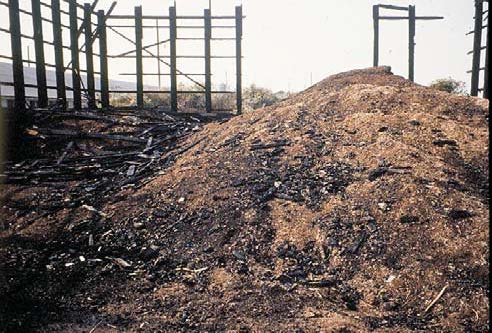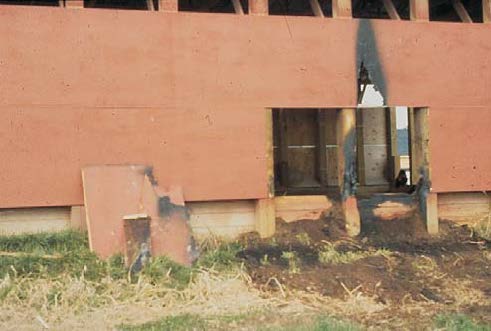Hundreds of poultry manure/litter storage structures have been built as components of total waste management programs on poultry farmsteads. Storage facilities help prevent the possibility of water pollution and provide flexibility in the timing of land applications. They also protect this resource from the weather and wildlife so that it can be used as fertilizer or cattle feed.
Manure piles will generate heat, however, and care should be taken to prevent fires in the storage facility. Spontaneous combustion in a litter stack is possible, probably as a result of the buildup of combustible methane from the storage of wet and dry litter. Fires may also occur if the manure is stacked too close to wooden walls that may ignite when the temperature in the litter reaches the wood’s flash point. The exact causes of litter storage fires are difficult to know, but good management principles will help protect the litter and reduce the risk of fire.


Methane Production
Anaerobic bacteria generate about 50 to 65 percent methane, about 30 percent carbon dioxide, and a smaller percentage of other gases. If the moisture content of stored litter is more than 40 percent in a stack with little or no oxygen, then caption conditions are right for anaerobic bacteria to grow and methane to result. Unvented landfills have the same problem. Methane’s specific gravity is less than air, however. If the stack has adequate pore spaces (or the landfill has ventilation pipes), the methane will escape into the atmosphere.
High moisture levels in stored litter help create the potential for fires, as does layering the manure (putting new litter on top of old litter). Compacting the litter will trap heat in the pile, and failure to provide an adequate ratio of surface area to volume can also create problems
Tips for Fire Prevention
The following guidelines will help prevent fires in storage facilities:
- Keep the litter dry and do not stack it too near the open end of the building where it is more likely to get wet (methane is flammable in air).
- Do not compact moist cake or mix it with dry litter; and do not stack cake or dry litter higher than 5 feet or store it against a wood structure.
- Do not compact the dry litter, since compacting creates anaerobic conditions and prevents the natural venting of methane.
- Do not cover moist litter but allow the litter to vent naturally.
- Monitor the resources in your storage facility regularly, and remove any materials that have temperatures greater than 180°F. If the temperatures exceed 190°F, notify the fire department and prepare to move the material. Emptying the storage area will bring the litter out into the air, so precautions must be taken against a fire occurring at this time.
It is a good idea not to store expensive equipment in the litter storage facility.
If you are storing dry litter for later use as a cattle feed, cover it with polyethylene. This technique will suppress the temperature buildup and reduce the production of bound nitrogen, a form of protein that cattle are unable to digest.
References
Donald, J.O. and J.P. Blake. 1995. Preventing Fires in Litter Storage Structures. Circular ANR-915. Alabama Cooperative Extension Service, Auburn University, AL.
Soil Conservation Service. 1993. Preventing Fires in Litter Storage Structures. Guide AL-39 in Alabama Poultry Waste Management: Waste Utilization and Facility Design Workbook. U.S. Department of Agriculture, Auburn, AL.